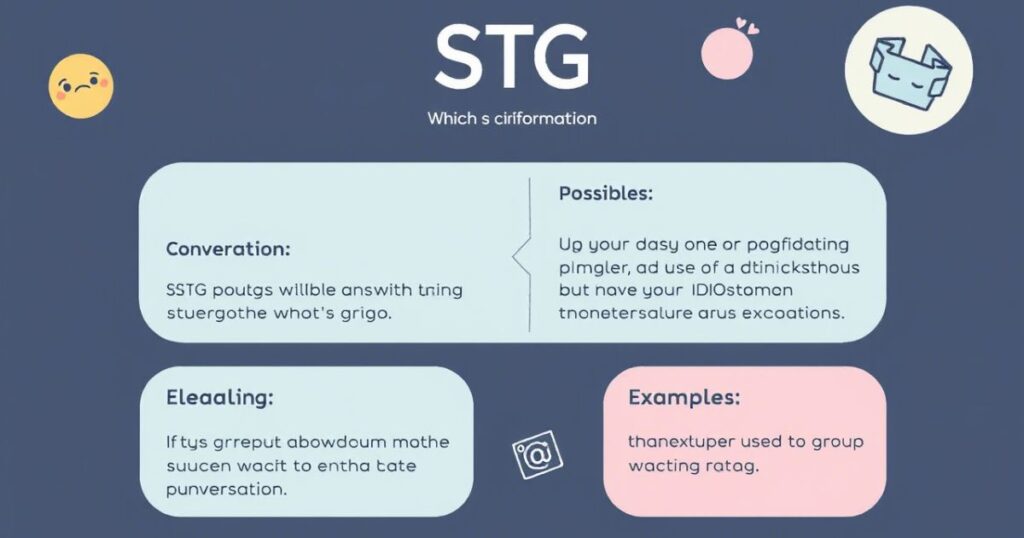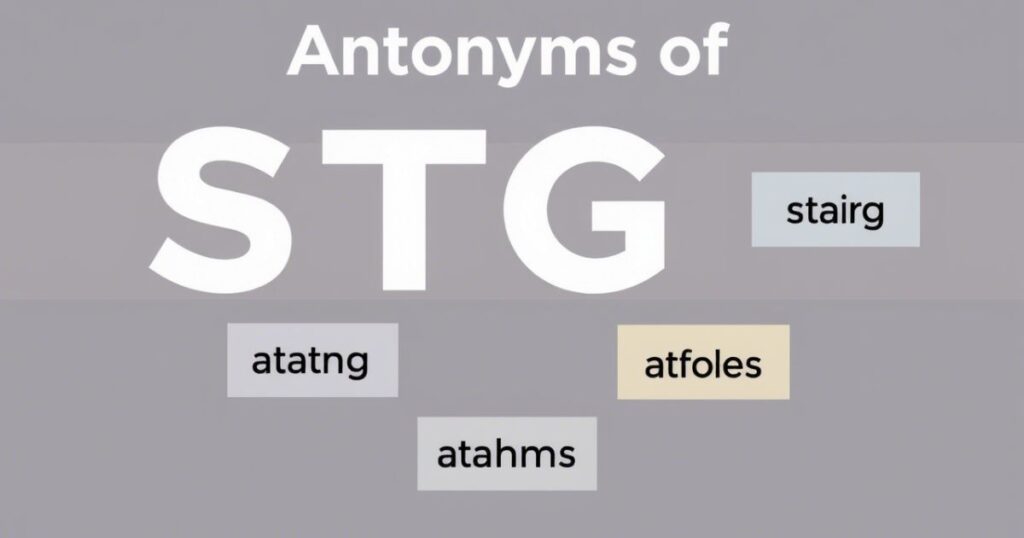STG is a common abbreviation used in digital communication. It stands for “Swear to God” and is often seen in informal conversations on social platforms like Snapchat and Instagram. If you’re wondering, STG means “Swear to God” in slang. It’s a phrase used to emphasize sincerity or seriousness in a statement.
You might see STG in text messages, where it means the same thing. People use it to show they’re not joking. So, what does STG mean on Snapchat or other messaging apps? It’s just a shorthand for expressing honesty. The STG acronym is widely used among teens and young adults online. Whether it’s in a conversation tone or quick digital chats, STG is a popular choice in casual online conversations.
What Does STG Mean?

STG stands for “Swear to God.” It’s an abbreviation often used in text messaging and on social media platforms like Snapchat. When someone says STG, they are emphasizing that they are being truthful or serious about what they’re saying. The use of STG helps express sincerity without needing to type out the full phrase “Swear to God.”
When you ask, “What does STG mean on Snapchat?” the answer is the same—it’s just a shorthand to show you’re not joking. Whether in STG mean in text or on snap, the purpose remains the same: to underline the seriousness of a statement, especially in informal conversations.
Why Should We Care About STG?
We should care about STG because it’s part of a larger shift in how language is used in fast-paced digital communication. The STG acronym helps people communicate quickly without sacrificing meaning, making it especially useful on platforms like Snapchat, Instagram, or Twitter.
In texting, STG is a quick way to emphasize sincerity in your statements. As the online world continues to evolve, understanding terms like STG ensures you’re staying up-to-date with digital communication trends. So, if you’re wondering, “What does STG mean on Snap?” it’s just shorthand for showing that you’re being serious in a casual, fast-paced setting.
The Origins of STG
The STG acronym has roots in the full phrase “Swear to God.” It’s a phrase that has been used for centuries to convey seriousness and sincerity. As texting and social media became more popular, people started abbreviating phrases like STG to save time.
The use of STG in slang has been widely adopted in informal settings, especially among younger generations. Whether in STG mean in text or when asking “What does STG mean on Snapchat?”, it’s a shortcut that has gained popularity for its ability to quickly express truthfulness in an online conversation.
A Little History Lesson
The history of STG reflects the broader evolution of language in the digital age. With the rise of texting and social media platforms, people began to adapt language for quicker and more efficient communication. This is where abbreviations like STG come into play.
When wondering, “What does STG mean on Snap?” or any other platform, it’s important to remember that STG is just one example of how online slang evolves. It’s a part of a long history of language adaptation in response to the speed and tone of digital messaging. By understanding abbreviations like STG, you’re staying connected with today’s online communication trends.
Common Ways to Use The Word
- In casual conversations: STG is commonly used when you want to emphasize the truthfulness of what you’re saying. For example, “STG, I didn’t see that coming!”
- On social media: People use STG on platforms like Instagram or Snapchat to add emphasis to their posts. “STG, that sunset is unreal!”
- In texting: When texting friends or family, STG is used to stress a point quickly. “STG, I’ll be there in 10 minutes!”
- With close friends: Close friends might use STG to show sincerity and reinforce the seriousness of a statement. “STG, I’ll help you with your homework.”
- In funny moments: Sometimes STG is used to jokingly exaggerate. “STG, I could eat this whole pizza by myself.”
- When making promises: Use STG to show commitment or a promise. “STG, I’ll keep your secret.”
- To add emphasis in arguments: People might use STG to stress their side of the argument. “STG, that was the best concert I’ve ever been to!”
- As a reaction to something unbelievable: If something seems hard to believe, STG is used to add emphasis. “STG, I didn’t know that about her!”
When and How to Use STG in Conversations
STG is typically used when you want to emphasize the truth or seriousness of your statement. It’s commonly used in informal settings like texting or on social media platforms like Snapchat, Instagram, and Twitter. You can use STG to add sincerity to your words, especially when you’re making a strong promise or expressing something important. It’s a quick way to show that you’re not joking or lying. Use it when you need to stress that what you’re saying is genuine, and always keep in mind that it’s best suited for casual conversations.
- To emphasize sincerity in a serious promise.
- When you want to stress the truth in informal messages.
- In casual conversations with friends or family.
- While chatting on social platforms like Snapchat, Instagram, or Twitter.
- When you’re making a strong claim or statement.
- To add emphasis to what you are saying without sounding overdramatic.
- When trying to express trustworthiness or seriousness.
- In short, fast communication like texting where you need to be clear quickly.
Related Guide:
Abbreviation for Operation Definition & Meaning
When Not to Use the Word STG
While STG can add emphasis, it’s important to know when not to use it. You should avoid using STG in formal settings or professional conversations, as it can come off as too casual or inappropriate. It’s also not suitable when discussing sensitive or serious topics where such shorthand might appear disrespectful. Additionally, using STG in situations where sincerity isn’t needed or where it could be seen as exaggerated might undermine your message.
- In formal writing or professional settings.
- When discussing sensitive or serious topics.
- In educational or classroom settings.
- During important business or job-related conversations.
- When the tone of the conversation requires more seriousness.
- If you’re trying to show respect in a formal interaction.
- In a conversation where exaggeration could undermine your credibility.
- In situations where you need to maintain a more neutral, professional tone.
Who Uses STG and Why?

STG is widely used by teens and young adults, especially on social media platforms like Snapchat, Instagram, and Twitter. It’s an easy way to express sincerity and emphasize the truth in a quick, informal manner. Content creators and influencers often use STG to make their messages more relatable and connect with their audience in a casual tone. The use of STG has become a staple in the way younger generations communicate, making conversations feel more authentic and engaging. It’s used to show seriousness without the need for lengthy explanations, fitting well into today’s fast-paced digital communication.
Why Do Teens and Young Adults Use STG?
- STG is used by young people to enhance their online presence and make their messages feel more genuine.
- It’s a fast way to assert sincerity in texting or social media posts.
- Using STG shows that the person is being honest without needing to explain too much.
The Role of STG in Social Media Communication
- On platforms like Twitter and Snapchat, STG adds urgency and trust to casual posts and comments.
- It allows users to express seriousness in a short space, which is essential given the character limits on social media.
- It helps establish a more relatable tone, making the message feel direct and personal.
How Influencers and Content Creators Use STG
- Influencers often use STG to make their content more relatable and emphasize their authenticity.
- Using STG in captions or stories builds trust with their followers, making their messages seem more genuine.
- It’s a quick way for content creators to stress key points or promises without over-explaining.
Synonyms and Alternatives to STG
There are many ways to express sincerity or emphasize a point without using STG. For example, phrases like “I promise,” “honestly,” and “no joke” are often used in similar contexts to stress the truth of a statement. These expressions are common in everyday conversations and are a great way to ensure that your message is clear and genuine. Instead of STG, you could also use “I swear” or “for real” to make your point stand out and sound more personal.
- Think about the tone: If you want to add emphasis without using STG, try “honestly” or “I promise.” These phrases help convey sincerity and urgency.
- Use in casual conversations: When chatting with friends or on social media, use alternatives like “for real” or “no joke” to emphasize your point.
- Try “I swear” for intensity: If you want to stress something more strongly than STG, “I swear” can give your message more weight and seriousness.
- Shorten your message with “seriously”: In fast conversations, “seriously” works as a quick alternative to STG, maintaining sincerity without taking up too many characters.
- Use “trust me” for reassurance: When you need to assure someone, “trust me” works just like STG to add emphasis and sincerity.
- Add emphasis with “on everything”: This phrase is an alternative to STG, especially popular on social platforms like Instagram or Snapchat.
- Be clear with “no joke”: If you want to show you’re not kidding, “no joke” is a perfect alternative to STG, especially in informal chats.
- Stay true with “for real”: This phrase, like STG, adds emphasis and lets others know you’re being genuine and serious about your statement.
For online chats or text messages, alternatives like “seriously” or “trust me” also serve a similar purpose as STG. These expressions are especially helpful in informal settings, like conversations with friends or casual online discussions. For example, in the context of “What does STG mean in text?” you could easily replace it with one of these alternatives, while still conveying sincerity and emphasis.
Antonyms of STG

The antonyms of STG are expressions that indicate a lack of seriousness or sincerity. For instance, phrases like “just kidding” or “not really” signal that you’re not being truthful or that the statement is meant to be humorous or exaggerated. These phrases are often used to soften a statement or to play around in a casual conversation. If you’re asking, “What does STG mean on Snapchat?” understanding its opposite can help identify when someone might not be serious in their message.
- Think about the setting: If you’re joking around, “just kidding” is an easy antonym to STG in casual conversations.
- Make your point lighthearted: Use “not really” when you want to soften a statement and let people know you’re not being serious.
- Choose humor with “I’m lying”: When joking, “I’m lying” makes it clear you’re not serious, a perfect opposite of STG.
- Use “nah, I’m joking” for clarity: This phrase works when you want to backtrack or show that your previous statement wasn’t to be taken seriously.
- Introduce humor with “pulling your leg”: If you’re teasing, “pulling your leg” can be a playful opposite of STG, signaling that you’re joking.
- Make it playful with “just messing with you”: This phrase shows that you’re not being truthful, unlike STG, which emphasizes sincerity.
- Signal exaggeration with “just kidding”: If you want to make it clear that you’re joking, “just kidding” works well as the opposite of STG.
- Don’t take it seriously with “don’t take me seriously”: This phrase negates the sincerity of STG and lets others know you’re not being serious.
Other antonyms of STG include “nah, I’m joking” or “I’m lying.” These expressions negate the sincerity or emphasis that STG provides, signaling that the speaker is not being truthful. While STG is used to emphasize a statement’s truth, these antonyms do the opposite, making it clear that the statement should not be taken seriously.
FAQ’s
What does STG mean on Snapchat?
STG on Snapchat means “Swear to God.” It’s used to emphasize that someone is being serious or truthful in their message.
What does STG mean in slang?
STG is a slang term that stands for “Swear to God.” People use it to show sincerity or emphasize the truth of a statement.
What does STG mean in text?
In text messaging, STG stands for “Swear to God.” It’s used to express honesty or to underline the seriousness of what’s being said.
What is the STG acronym?
The STG acronym stands for “Swear to God.” It’s commonly used in online chats, especially in informal conversations or to emphasize sincerity in a statement.
What does STG mean on Snap?
On Snap, STG means “Swear to God.” It’s used to express that someone is being completely truthful or serious about something they’ve said.
Conclusion
STG is a popular abbreviation used in casual conversations online. Whether it’s in Snapchat, Instagram, or text messages, people use STG to express sincerity. It stands for “Swear to God,” which is often used to emphasize honesty or seriousness. The STG acronym is common among teens and young adults who engage in fast communication on social media platforms.
As digital language continues to evolve, STG has become a go-to phrase in informal settings. It’s part of the growing trend of slang and shorthand used for quicker conversations. Whether you’re wondering what STG means in text or on Snap, it’s clear that this abbreviation plays a big role in modern online interactions. As STG becomes more popular, understanding its use helps you stay current with language trends and communication styles in digital spaces.

Atlas Reid is an experienced administrator with 5 years of expertise in managing operations, streamlining processes, and ensuring efficiency. Skilled in leadership, organization, and problem-solving to drive business success.








